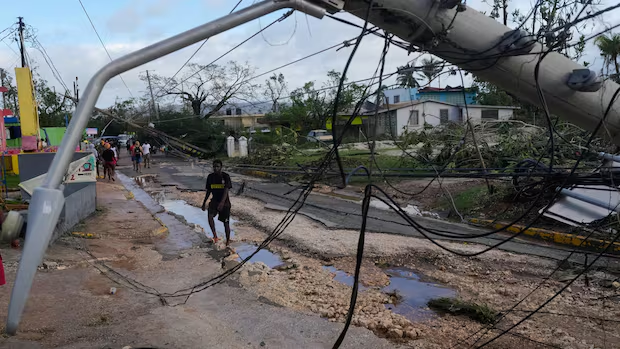‘That was hell’: Cubans, Jamaicans to assess Hurricane Melissa damage as storm churns in Caribbean | CBC News

Hurricane Melissa brought dangerous flooding and storm surge to Cuba on Wednesday, after leaving Jamaica with widespread power outages and causing flooding that killed 25 people in Haiti, officials say.
All 25 people died after La Digue river burst its banks and flooded nearby homes, Jean Bertrand Subrème, the mayor of the southern Haitian coastal town of Petit-Goâve, told The Associated Press.
Dozens of homes collapsed and people were still trapped under rubble as of Wednesday morning, he said.
People are shown late Tuesday sleeping at a school that was used as a shelter during Hurricane Melissa’s path, in Les Cayes, Haiti. (Patrice Noel/Reuters)
“I am overwhelmed by the situation,” he said as he pleaded with the government to help rescue victims.
Only one official from Haiti’s Civil Protection Agency was in the area, with residents struggling to evacuate amid heavy floodwaters unleashed by Hurricane Melissa in recent days.
Melissa had top sustained winds of 155 kilometres per hour at 11 a.m. ET and was moving northeast at 22 km/h, according to the U.S. National Hurricane Center in Miami. The hurricane was centered about 245 kilometres south of the central Bahamas.
Residents walk through Santa Cruz, Jamaica on Wednesday, after Hurricane Melissa passed. (Matias Delacroix/The Associated Press)
Officials reported collapsed houses, blocked mountain roads and roofs blown off in Cuba on Wednesday, with the most destruction concentrated in the southwest and northwest. Authorities said about 735,000 people remained in shelters in eastern Cuba.
“That was hell. All night long, it was terrible,” said Reinaldo Charon in Santiago de Cuba. The 52-year-old was one of the few people venturing out Wednesday, covered by a plastic sheet in the intermittent rain.
Melissa tore off roofs and uprooted trees in the province, but the full extent of damage wasn’t immediately known.
Melissa crossed Cuba as a Category 3 hurricane, and was forecast to weaken but remain strong as it moved across the southeastern or central Bahamas later Wednesday. It was expected to make its way near or to the west of Bermuda late Thursday. Haiti and the Turks and Caicos also braced for its effects.
WATCH | The conditions that fuelled Melissa:
Hurricane Melissa: a case study in a changing hurricane era
Hurricane Melissa’s Category 5 winds tore into western Jamaica Tuesday morning, marking one of the most powerful Atlantic landfalls ever recorded. CBC’s Johanna Wagstaffe looks at how Melissa may be part of a new hurricane era: storms fuelled by record-warm seas and slowed by a shifting jet stream.
‘It’s not going to be an easy road’
Parts of Granma province, especially the municipal capital, Jiguaní, were underwater, said Gov. Yanetsy Terry Gutiérrez. More than 40 centimetres of rain was reported in Jiguaní’s settlement of Charco Redondo.
The hurricane could worsen Cuba’s severe economic crisis, which already has led to prolonged power blackouts, fuel shortages and food shortages.
Cuban residents evacuate in pouring rain from Playa Siboney to safe locations in Santiago de Cuba on Tuesday. ( Yamil Lage/AFP/Getty Images )
“There will be a lot of work to do. We know there will be a lot of damage,” President Miguel Díaz-Canel said in a televised address, in which he assured that “no one is left behind and no resources are spared to protect the lives of the population.”
In Jamaica, more than 25,000 people were packed into shelters Wednesday, hours after Melissa made landfall as a catastrophic Category 5 storm with top winds of 295 km/h — one of the strongest Atlantic hurricanes on record.
People kept streaming into the shelters throughout the day after the storm ripped off the roofs of their homes and left them temporarily homeless.
WATCH | Scenes from Jamaica after the storm:
See the impact of Hurricane Melissa
Hurricane Melissa hammered parts of Jamaica before slamming into Cuba, leading to widespread damage, power outages and, in some areas, dangerous flooding.
“It’s not going to be an easy road, Jamaica,” said Desmond McKenzie, deputy chair of Jamaica’s Disaster Risk Management Council.
Dana Morris Dixon, Jamaica’s education minister, said that 77 per cent of the island was without power Wednesday but the water systems weren’t greatly affected.
Federal officials said they hadn’t yet received any reports of deaths after Melissa made landfall, but that they couldn’t presume that would remain the case, given how soon it was in the recovery effort.
The government earlier said it hopes to reopen all of Jamaica’s airports as early as Thursday to ensure the quick distribution of emergency relief supplies.
The storm already was blamed for seven deaths in the Caribbean: three preparation-related deaths in Jamaica; three earlier deaths in Haiti; and one in the Dominican Republic, where another person remains missing.





